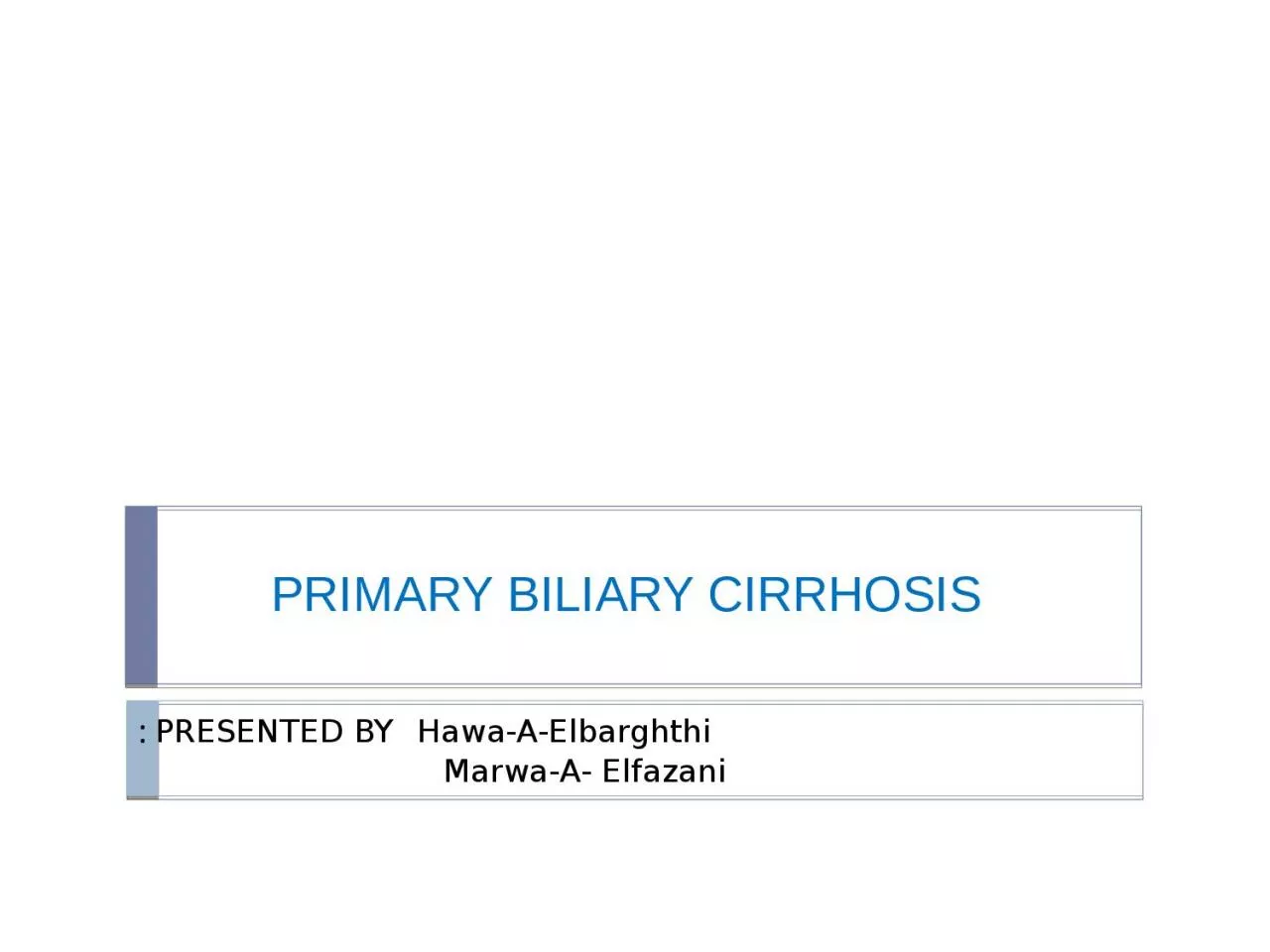

PRESENTED BY HawaAElbarghthi MarwaA Elfazani It is an autoimmune disease of the liver by the slow progressive destruction of the small bile ducts bile canaliculi within the liver ID: 1000053
Download Presentation The PPT/PDF document "PRIMARY BILIARY CIRRHOSIS" is the property of its rightful owner. Permission is granted to download and print the materials on this web site for personal, non-commercial use only, and to display it on your personal computer provided you do not modify the materials and that you retain all copyright notices contained in the materials. By downloading content from our website, you accept the terms of this agreement.
1. PRIMARY BILIARY CIRRHOSIS PRESENTED BY : Hawa-A-ElbarghthiMarwa-A- Elfazani
2. It is an autoimmune disease of the liver by: the slow progressive destruction of the small bile ducts (bile canaliculi) within the liver. when these ducts are damaged, bile builds up in the liver (cholestasis) and over time damages the tissue. this can lead to scarring, fibrosis and cirrhosis. Primary biliary cirrhosis
3. Female : male ratio of 9:1 Most common during middle age Commonest in northern Europeans, least common in Africans Prevalence: 19-150 cases/million Incidence: 4-15 cases/million/yr First-degree relatives may have as much as a 500 times increase in prevalenceEpidemiology
4. Fatigue (most common) Itching (Pruritus)Dry skin and eyesAbnormal bleeding or bruisingJaundiceXanthelasma and xanthomataHepatosplenomegalyFeatures of chronic liver diseasePalmar erythema; spider naevi; cachexia; ascitesPale stool or dark urineClinical features
5. Biliary stones or stricturesPancreaticobiliary malignanciesAutoimmune hepatitisAlcoholic hepatitisViral hepatitisSarcoidosisAutoimmune cholangiopathyMedicationsGranulomatous hepatitisPBC Differential diagnosis
6. Blood tests:Liver function tests elevated alkaline phosphatase ALP and gamma-glutamyl transferase GGT are found in early disease. Elevations in bilirubin occur in advanced disease.ClottingElevated prothrombin timeFull blood countTrombocytopenia if cirrhosis presentSerum lipidsCholesterol, LDL and HDL all significantly raisedFull liver screen of blood tests to rule out other causes of liver disease (see chronic liver disease section)diagnosis of primary biliary cirrhosis
7. Autoimmune screen:Serum antimitochondrial M2 antibodies (95% sensitive, 98% specific)Elevated serum immunoglobulins, especially IgM Radiology Ultrasound liver to look for focal liver lesions, portal/hepatic vein thrombosis, extrinsic causes of biliary duct compression. Magnetic resonance cholangiopancreatography (MRCP) gives a more detailed view of the biliary tree and does not have the associated morbidity of Endoscopic retrograde cholangio pancreatography (ERCP).CT abdomen : This is more likely to be performed if an extrahepatic cause of cholestasis is suspected.Liver biopsyA liver biopsy is necessary to determine the stage of disease.
8. Stage 1 - Portal Stage: Normal sized triads; portal inflammation, subtle bile duct damage. Granulomas are often detected in this stage. Stage 2 - Periportal Stage: Enlarged triads; periportal fibrosis and/or inflammation. Typically characterized by the finding of a proliferation of small bile ducts. Stage 3 - Septal Stage: Active and/or passive fibrous septa. Stage 4 - Biliary Cirrhosis: Nodules present; garland or jigsaw pattern.stages of the disease
9. Complications and associations of primary biliary cirrhosisOsteoporosisMalabsorption of fats and fat-soluble vitamins can lead to osteomalacia and coagulopathiesLiver cirrhosis and its complications Renal tubular acidosisAssociated conditionsHypothyroidism (seen in up to 20%) of patientsRheumatoid arthritis; Systemic sclerosis; Sjogren’s syndrome; Sicca syndromeComplications and associations of PBC
10. medical treteamt If PBC is diagnosed at an early histologic stage and treatment with UDCA is begun, recent studies have suggested that the long-term survival approaches that of a healthy control population.*Ursodeoxycholic acid (UDCA) 13-15mg/kg/day in usually two divided dosesCan be used in any patient with PBC and abnormal liver biochemistry.Can significantly improve liver biochemistry and reduce the need for liver transplantation and overall mortality.has no effect on pruritus, fatigue or associated bone diseaseChronic management of primary biliary cirrhosis
11. Steroids and other immunosuppressive agentsPrednisolone has been shown to significantly improve liver biochemistry, however, it makes bone disease much worse and thus is not recommended long-termSteroid-sparing immunosuppressant drugs have not been shown to be effective in PBC
12. Anti-pruritics :Cholestyramine: 4g per dose up to 16g/day given 2-4 hours apart from UDCA.Rifamipicin at a dose of 150mg once or twice dailyOpiate agonists such as Naltrexone at a starting dose of 50mg dailySurgcial Orthotopic liver transplantationIs indicated in patients with end-stage diseasePatients should be referred when the bilirubin level is > 100 micromls/litre or earlier if debilitating symptoms.Up to 20-25% of patients will have disease recurrence at 10 years post-transplant
13. Some studies suggest that asymptomatic patients have a 50-70% 10 year survival whereas median survival from onset of symptoms is 5-8 years.The serum bilirubin level is a marker of prognosisPrognosis of primary biliary cirrhosis
14. THANK YOU